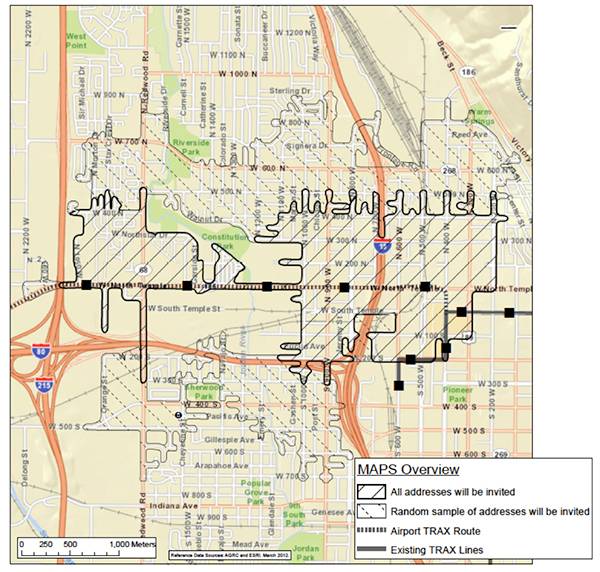Moving Across Places Study (MAPS)
What is MAPS?
The University of Utah conducted the Moving Across Places Study (MAPS) to examine how significant changes in neighborhoods around North Temple affect travel and activity patterns, as well as residents’ perceptions and feelings about their neighborhoods. The study involved eligible participants completing surveys about their neighborhood perceptions, activity patterns, and individual characteristics, with all responses kept confidential. The research surveyed residents before and after major local construction projects. The findings have been valuable for cancer prevention research and have been shared with national, state, and local leaders.
Conducted by
Faculty, students, and employees from the University of Utah.
Sponsor
National Cancer Institute
Overview & Objective
 The National Cancer Institute is involved in this study to understand how community
designs can encourage residents to engage in behaviors that prevent cancer. Activities
like walking, using public transportation, and feeling positive about one’s neighborhood
are linked to reducing the risk of breast, colon, and other cancers. The study aims
to assess residents’ opinions on these community design changes and how they impact
travel and activity patterns. This information could help other communities considering
similar changes.
The National Cancer Institute is involved in this study to understand how community
designs can encourage residents to engage in behaviors that prevent cancer. Activities
like walking, using public transportation, and feeling positive about one’s neighborhood
are linked to reducing the risk of breast, colon, and other cancers. The study aims
to assess residents’ opinions on these community design changes and how they impact
travel and activity patterns. This information could help other communities considering
similar changes.
As a participant, a research assistant will visit you at home or another location to conduct a survey about your feelings towards your neighborhood and its changes. You will sign an informed consent form, ensuring your participation is confidential and voluntary. Your height and weight will be measured, and you will be given two gadgets to wear for a week: a motion meter (accelerometer) to track movement intensity and a GPS unit to map your travel patterns. The data collected will help identify healthy activities like brisk walking. Participation does not require you to be a regular walker, as the study seeks a diverse group of neighborhood adults. Each visit at the beginning and end of the week will take about 45-60 minutes.
The study’s first phase runs from spring through fall 2012, with a second phase planned for 2013 or 2014, followed by a short follow-up about a year later. Participants receive an invitation letter signed by Dr. Barbara Brown, the principal investigator. Research assistants may leave a phone number or a letter/flyer at your address for contact.
The gadgets used in the study measure activity levels and locations visited. The motion meter records acceleration, indicating movement levels but not specific activities. The GPS unit maps travel patterns when data is downloaded at the end of the week. Both gadgets together can identify activities like walking or bus riding. Data is stored on the GPS unit and not transmitted during the week.
To ensure confidentiality, the University of Utah employs strict measures. Personal information is kept in locked cabinets and secured computers. Participants are assigned arbitrary code numbers, with names and addresses stored separately from data files. A key linking your number to your contact information is kept in a separate locked file for future study rounds.
In the News
- June 23, 2012 - SLC residents pull weeds to spruce up Jordan River trails (SL Tribune)
- July 10, 2012 - U of U Seeks Participants for Study on North Temple Upgrades (KCPW)
- July 10, 2012 - People living in North Temple area needed for study on making streets more livable (Deseret News)
- Aug. 23, 2012 - Will North Temple overhaul help residents get more exercise? (SL Tribune)
Research Team
Staff
- Dr, Barbara Brown; Emeritus Professor, University of Utah
- Dr. Carol Werner; Professor, University of Utah
- Dr. Ken Smith; Emeritus Professor, University of Utah
- Harvey Miller; Professor, University of Utah
Graduate Students
- Austin Strebel; FCS Department, University of Utah
- Calvin Tribby; Geography Department, University of Utah
- Alyssa Messina; Psychology Department, University of Utah
Supporters
Community
- Mayor Ralph Becker, Salt Lake City
- Maria Garciaz, Neighborworks
- Dave Patton, Utah Department of Health
- Kay Cameron, Northwest Recreation Center
- Heather Aiono, Community Faces of Utah
- Kyle LaMalfa, Salt Lake City Council
Staff
- Jean Wolf and Laura Wilson, GeoStats
- Melissa Warner, The University of Utah DIGIT lab
- Josh Shupe, Computing Lab Manager, CSBS University of Utah
